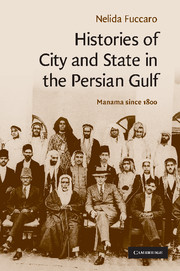Book contents
- Frontmatter
- Contents
- List of illustrations
- List of maps
- Acknowledgements
- Note on transliteration and terminology
- Glossary
- List of abbreviations
- Map 1 The Persian Gulf and Bahrain in the regional context
- Map 2 Bahrain's settlements
- CAMBRIDGE MIDDLE EAST STUDIES 30
- Introduction
- 1 Indigenous state traditions and the dialectics of urbanisation in Bahrain, 1602–1923
- 2 The making of Gulf port towns before oil
- 3 Ordering space, politics and community in Manama, 1880s–1919
- 4 Restructuring city and state: the municipality and local government
- 5 ‘Disorder’, political sociability and the evolution of the urban public sphere
- 6 City and countryside in modern Bahrain
- Conclusion
- Bibliography
- Index of persons, tribes and families
- Index of subjects
- Index of places
Introduction
Published online by Cambridge University Press: 20 January 2010
- Frontmatter
- Contents
- List of illustrations
- List of maps
- Acknowledgements
- Note on transliteration and terminology
- Glossary
- List of abbreviations
- Map 1 The Persian Gulf and Bahrain in the regional context
- Map 2 Bahrain's settlements
- CAMBRIDGE MIDDLE EAST STUDIES 30
- Introduction
- 1 Indigenous state traditions and the dialectics of urbanisation in Bahrain, 1602–1923
- 2 The making of Gulf port towns before oil
- 3 Ordering space, politics and community in Manama, 1880s–1919
- 4 Restructuring city and state: the municipality and local government
- 5 ‘Disorder’, political sociability and the evolution of the urban public sphere
- 6 City and countryside in modern Bahrain
- Conclusion
- Bibliography
- Index of persons, tribes and families
- Index of subjects
- Index of places
Summary
Why cities and urban history?
It is peculiar that urban history has been conspicuously absent from the study of the Arab coast of the Persian Gulf in the nineteenth and twentieth centuries, peppered as that region is by a chain of city-states – or quasi city-states – stretching from Kuwait to Oman. The history of cities and urban societies in this region has featured only as a corollary to that of tribes, British Empire and oil. Of course the pivotal role of tribesmen, British officials and oil wealth as agents of historical change can be hardly overstated. Tribal communities constituted the backbone of the political infrastructure of the Gulf coast in the nineteenth century and developed a symbiotic, albeit often conflicting, relationship with the British authorities who controlled the region between 1820 and 1971. British protection ensured the political stability of the local tribal principalities within the new regional order of nation-states which took shape after World War I. After the 1930s, the discovery of oil gradually transformed the lives of Gulf peoples beyond recognition, altering their social and political identities and their relationship with their living environments.
The study of the politics of empire and tribalism, which has been the staple of regional historiography, has imposed a number of constraints on our understanding of indigenous societies and political cultures. External factors have been paramount in explaining historical change through the lens of British influence.
- Type
- Chapter
- Information
- Histories of City and State in the Persian GulfManama since 1800, pp. 1 - 15Publisher: Cambridge University PressPrint publication year: 2009

